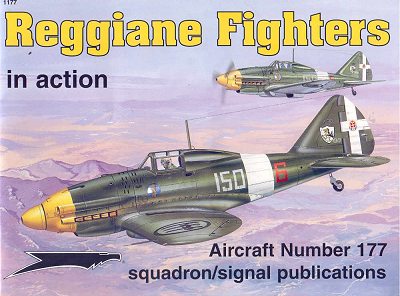|
BOOK
/PERIODICAL: |
Reggiane Fighters
in Action |
|
BY: |
George Punka |
|
PUBLISHER
/PRICE: |
Squadron Signal
Publications
$10.95 |
|
REVIEW BY: |
Tom Cleaver |
|
NOTES: |
Aircraft # 177 |
 The Reggiane series of fighters are generally obscure to most
modelers who are not knowledgeable about aircraft of the Italian Air Force. This
obsucrity was ill-deserved by one of the best basic designs to ever be created
in Italy in the period of the Second World War. The aircraft showed a strong
influence from the Seversky P-35, owing to the fact that designer Roberto Longhi
had spent several years at Seversky working for chief engineer Alexander
Kartveli before returning to Italy in 1936. The Reggiane fighter was an
improvement over the P-35 aerodynamically and technically, which led to the
original Re.2000 being nearly 25 mph faster than its progenitor, despite the
fact it used a less-powerful engine. The downfall of the airplane was the
engine, which was a maintenance hog, and the wet wing, which gave great range
but leaked. In the end, fewer than 300 of this fighter would serve in the
Italian and Hungarian Air Forces.
The Reggiane series of fighters are generally obscure to most
modelers who are not knowledgeable about aircraft of the Italian Air Force. This
obsucrity was ill-deserved by one of the best basic designs to ever be created
in Italy in the period of the Second World War. The aircraft showed a strong
influence from the Seversky P-35, owing to the fact that designer Roberto Longhi
had spent several years at Seversky working for chief engineer Alexander
Kartveli before returning to Italy in 1936. The Reggiane fighter was an
improvement over the P-35 aerodynamically and technically, which led to the
original Re.2000 being nearly 25 mph faster than its progenitor, despite the
fact it used a less-powerful engine. The downfall of the airplane was the
engine, which was a maintenance hog, and the wet wing, which gave great range
but leaked. In the end, fewer than 300 of this fighter would serve in the
Italian and Hungarian Air Forces.
The fighter whose presence makes the book
so timely in its release is the Re.2001 - the DB-601 powered development of the
original Re.2000 - since Classic Airframes has recently released an excellent
1/48 injection-molded kit of the airplane.
As is usual with the "In Action" series,
there are numerous photographs of all the various variants and sub-types of each
of the Reggiane fighters - the Re.2000 Falco, Re.2001 Falco II, Re.2002 Ariete,
Re.2005 Sagittario, and the MAVAG Heja II - the Hungarian development of the
Re.2000. The text is well-written and informative, while Don Greer's excellent
color profiles and color illustrations provide inspiration to modelers.
If you are going to build the Classic
Airframes kit, you can't afford not to have this useful reference while doing
so.
If you would like your product reviewed fairly and quickly by a
site that has thousands of visits a day, please contact
me or see other details in the Note to
Contributors.
 The Reggiane series of fighters are generally obscure to most
modelers who are not knowledgeable about aircraft of the Italian Air Force. This
obsucrity was ill-deserved by one of the best basic designs to ever be created
in Italy in the period of the Second World War. The aircraft showed a strong
influence from the Seversky P-35, owing to the fact that designer Roberto Longhi
had spent several years at Seversky working for chief engineer Alexander
Kartveli before returning to Italy in 1936. The Reggiane fighter was an
improvement over the P-35 aerodynamically and technically, which led to the
original Re.2000 being nearly 25 mph faster than its progenitor, despite the
fact it used a less-powerful engine. The downfall of the airplane was the
engine, which was a maintenance hog, and the wet wing, which gave great range
but leaked. In the end, fewer than 300 of this fighter would serve in the
Italian and Hungarian Air Forces.
The Reggiane series of fighters are generally obscure to most
modelers who are not knowledgeable about aircraft of the Italian Air Force. This
obsucrity was ill-deserved by one of the best basic designs to ever be created
in Italy in the period of the Second World War. The aircraft showed a strong
influence from the Seversky P-35, owing to the fact that designer Roberto Longhi
had spent several years at Seversky working for chief engineer Alexander
Kartveli before returning to Italy in 1936. The Reggiane fighter was an
improvement over the P-35 aerodynamically and technically, which led to the
original Re.2000 being nearly 25 mph faster than its progenitor, despite the
fact it used a less-powerful engine. The downfall of the airplane was the
engine, which was a maintenance hog, and the wet wing, which gave great range
but leaked. In the end, fewer than 300 of this fighter would serve in the
Italian and Hungarian Air Forces.